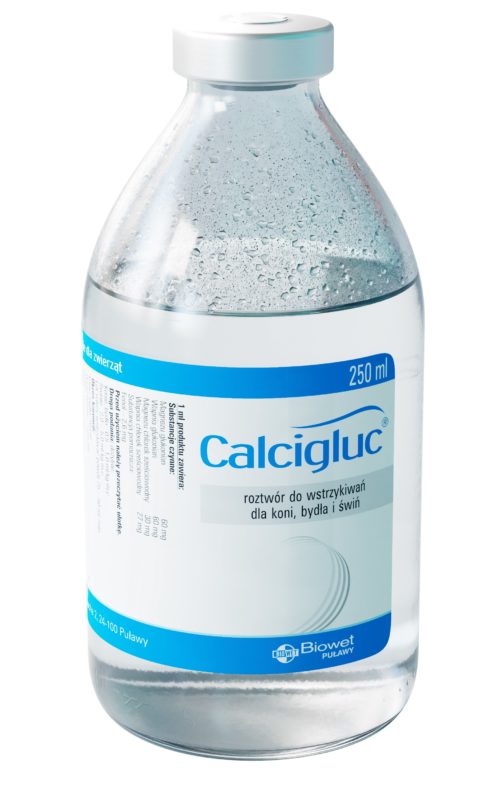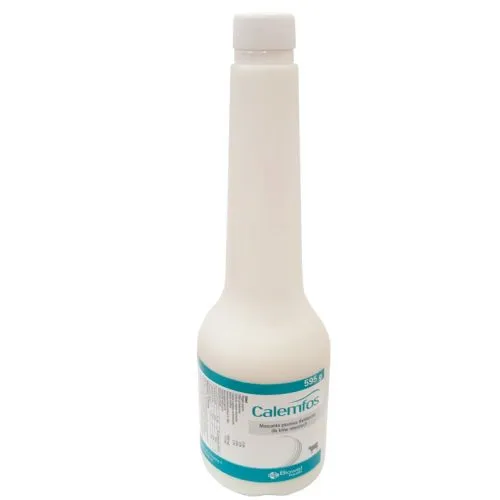Description
Calmagluc (60 mg + 22 mg +30 mg +100 mg)/ml solution for injection for cattle, horses, pigs and dogs
Statement of the active substance(s) and other ingredient(s)
Each ml contains:
Active substance:
Calcium gluconate 60 mg
Calcium hypophosphite 22 mg
Magnesium chloride hexahydrate 30 mg
Glucose monohydrate 100 mg
Excipient:
Phenol 2.6 mg
Clear, colourless or slightly yellow solution.
Target species
Cattle, horses, pigs, dogs.
Indications for use
Solution for injection is intended for use in horses, cattle, pigs and dogs in case of calcium and magnesium deficiency. The product is used to treat clinical and subclinical hypocalcaemia, hypomagnesemia and hypoglycaemia, parturient paresis in cows, puerperal tetany in dogs, postparturient hypocalcaemia in sows.
This veterinary medicinal product can also be used in treating allergies (particularly urticaria), as well as subacute and chronic disorders of calcium and magnesium metabolism, such as Downer cow syndrome and subclinical hypomagnesemia.
The product is also used in treatment of diseases caused by calcium-phosphate metabolism disorders, such as rickets, osteomalacia and fibrous osteodystrophy. In addition, it is administered during treatment of diseases involving increased neuromuscular excitability, such as e.g. hypomagnesaemia-induced tetany in cattle, tetanus, rhabdomyolysis in horses, as well as inflammations and poisoning with signs of increased vascular permeability, e.g. pulmonary and cerebral oedema, oedema disease in piglets, laminitis in horses (as an ancillary drug).
Contraindications
Hyperparathyroidism and renal failure.
Hypercalcaemia, acidosis.
Hypermagnesemia, Myastenia gravis in dogs, heart conduction disorders.
Earlier treatment with cardiac glycosides, beta-adrenergic agonists and caffeine.
Special warnings
Special warnings:
Take caution when using in animals with poor health condition, in which excessively high product doses may lead to myocardial hypoxia and lowered blood pressure leading to collapse.
Special precautions for safe use in the target species:
In case of intravenous injection, warm the product to body temperature and inject slowly (25 – 50 ml/min in large animals, 15-30 ml/min in small animals). For example: 500 ml of the product in large animals should be administered for not less than 5 to 10 minutes.
To prevent overdosing, determine body weight as accurately as possible.
In order to recognise symptoms of overdose in good time, monitor heart functions during the injection.
Special precautions to be taken by the person administering the veterinary medicinal product to animals:
Do not eat, drink and smoke when handling the product.
Take special caution to avoid self-injection.
In case of accidental self-injection, seek medical advice immediately and show the package leaflet or the label to the physician.
Wash hands after use.
Pregnancy and lactation:
Can be used during pregnancy and lactation.
Interaction with other medicinal products and other forms of interaction:
Cardiac glycosides enhance cardiotoxic action of calcium ions. Beta-adrenergic agonists and methylxanthines enhance the effect of calcium ions on the heart. Simultaneous oral administration of tetracyclines increases binding of calcium ions with proteins.
It is not recommended to use the product simultaneously with thiazide diuretics, glucocorticoids, ion-exchange resins, oxalic and phytic acids, laxatives, e.g. paraffin oil.
Due to magnesium ion content, this veterinary medicinal product can act as an antagonist of other calcium preparations. Magnesium decreases absorption of theophylline, tetracyclines, iron preparations, fluoride compounds, as well as oral anticoagulants, warfarin derivatives from the digestive tract.
Diuretics, cisplatin, cycloserine, mineralocorticoids increase urinary excretion of magnesium. Aminoglycosides, relaxants and colistin used simultaneously with magnesium preparations may cause paralysis. As a result of urine alkalinization, renal clearance of quinidine is reduced, which involves the risk of overdose.
Overdose:
Overdosing the product leads to hypercalcemia and hypermagnesemia, and to increased urinary excretion of calcium and magnesium. Symptoms of hypercalcemia and/or hypermagnesemia may include: nausea, vomiting, polydipsia, polyuria, dehydration and constipation. Long-term overdose leading to hypercalcemia and/or hypermagnesemia may cause vascular and internal organ calcification. In case of overdose, discontinue treatment immediately and replenish fluid deficiency. In case of long-term overdose, use oral and intravenous rehydration with NaCl solutions. Simultaneously (or after rehydration) administer loop diuretics (e.g. Furosemide) in order to increase calcium excretion and prevent the increase in the fluid volume. Do not administer thiazide diuretics. Arrhythmia is a symptom of overdose. When it occurs, discontinue administration of the product.
Major incompatibilities:
In the absence of compatibility studies, this veterinary medicinal product must not be mixed with other veterinary medicinal products.
Adverse events
Target species: horses, cattle, pigs, dogs.
| Very rare (< 1 animal/10 000 animals treated, including isolated reports) | Hypercalcemia1 |
1 May occur during intravenous injection of high product doses, particularly in animals in poor health condition. In case of hypercalcemia, bradycardia is observed, the power of muscle contraction and contraction rate increase, followed by tachycardia and extra contractions. Presented symptoms include sweats, anxiety, muscle tremor, lowered blood pressure leading to collapse; acute myocardial hypoxia is developed.
The safety margin for calcium gluconate, magnesium chloride, calcium hypophosphite and glucose is high, whereas the potential toxic effect requires administration of doses exceeding therapeutic doses multiple times.
Reporting adverse events is important. It allows continuous safety monitoring of a veterinary medicinal product. If you notice any side effects, even those not already listed in this package leaflet, or you think that the medicine has not worked, please contact, in the first instance, your veterinarian. You can also report any adverse events to the marketing authorization holder using the contact details found at the end of this leaflet, or via your national reporting system: Department for Documentation Assessment and Pharmacovigilance of Veterinary Medicinal Products, Office for Registration of Medicinal Products, Medical Devices and Biocidal Products, Al. Jerozolimskie 181C, PL-02-222 Warsaw, Tel.: +48 22 49-21-687, Fax: +48 22 49-21-605, https://smz.ezdrowie.gov.pl
Dosage for each target species, routes and method of administration
The product is intended for intravenous or intramuscular use. In horses and dogs, it should be administered intravenously only.
In case of intravenous injection, warm the product to body temperature and inject slowly (25 – 50 ml/min in large animals, 15-30 ml/min in small animals). For example: 500 ml of the product in large animals should be administered for not less than 5 to 10 minutes.
Depending on the disease, administer the product to cattle, horses, pigs and dogs as follows:
Chronic and subacute, both primary and secondary metabolism disorders of basic macronutrients, and diseases caused by calcium-phosphate metabolism disorders, such as rickets, osteomalacia and fibrous osteodystrophy – administer a dose of 0.5 ml/kg bodyweight intravenously or intramuscularly, once daily for 3 to 7 days. Extend treatment with administration of mineral mixtures.
Acute disorders with advanced hypocalcaemia and hypomagnesaemia, such as parturient paresis and tetany caused by hypomagnesaemia – administer a dose of 1.0-1.5 ml/kg bodyweightintravenously or intramuscularly, once, twice and, exceptionally, three times, at 12 hour intervals.
Diseases not directly related to calcium-magnesium metabolism disorders and as a supplement in inflammations, allergies and toxicity (urticaria, laminitis, oedema, increased neuromuscular excitation) – administer a dose of 0.3-0.5 ml/kg bodyweight, every second day for 6 to 14 days.
Advice on correct administration
In case of intravenous injection, warm the product to body temperature and inject slowly (25 – 50 ml/min in large animals, 15-30 ml/min in small animals). For example: 500 ml of the product in large animals should be administered for not less than 5 to 10 minutes.
Withdrawal period(s)
Dogs – not applicable.
Cattle, horses, pigs – zero days.
Special storage precautions
Keep out of the sight and reach of children.
Store below 25℃. Protect from light. Do not freeze.
Do not use this veterinary medicinal product after the expiry date which is stated on the label after EXP. The expiry date refers to the last day of that month.
Shelf life after first opening the immediate packaging: 28 days
Special precautions for disposal
Medicines should not be disposed of via wastewater or household waste.
Use take-back schemes for the disposal of any unused veterinary medicinal product or waste materials derived thereof in accordance with local requirements and with any applicable national collection systems. These measures should help to protect the environment.
Ask your veterinary surgeon how to dispose of medicines no longer required.
Classification of veterinary medicinal products
Veterinary medicinal product subject to prescription
Marketing authorisation numbers and pack sizes
1317/02
Pack size: 250 ml
Date on which the package leaflet was last revised
26/09/2024
Detailed information on this veterinary medicinal product is available in the Union Product Database (https://medicines.health.europa.eu/veterinary).
Contact details
Marketing authorisation holder and manufacturer responsible for batch release:
Biowet Puławy Sp. z o.o.
Henryka Arciucha 2
24-100 Puławy
Poland
Tel./Fax: + 48 (81) 886 33 53, Tel.: + 48 (81) 888 91 00
e-mail: sekretariat@biowet.pl
Contact details to report suspected adverse events:
Biowet Puławy Sp. z o.o.
Henryka Arciucha 2
24-100 Puławy
Poland
Tel: + 48 (81) 888 91 33, + 48 509 750 444
e-mail: biowet@biowet.pl
SPC 2024-09-26
2025-03-21






